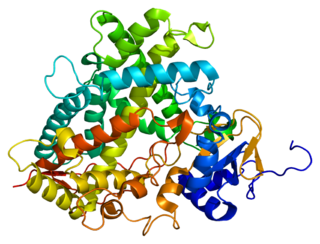Cytochrome P450 1B1 is an enzyme that in humans is encoded by the CYP1B1 gene. [5]
Cytochrome P450 1B1 is an enzyme that in humans is encoded by the CYP1B1 gene. [5]
CYP1B1 belongs to the cytochrome P450 superfamily of enzymes. The cytochrome P450 proteins are monooxygenases which catalyze many reactions involved in drug metabolism and synthesis of cholesterol, steroids, and other lipids. The enzyme encoded by this gene localizes to the endoplasmic reticulum (ER) and metabolizes procarcinogens such as polycyclic aromatic hydrocarbons and 17beta-estradiol.
Despite over 20 years of research on CYP1A1 and CYP1A2, CYP1B1 was not identified and sequenced until 1994. Nucleic and amino acid analysis showed approximately 40% identity with CYP1A1. Despite this similarity, these two enzymes have very different catalytic efficiencies and metabolites when incubated with common substrates, such as retinoic acid and arachidonic acid. Recently CYP1B1 has been shown to be physiologically important in fetal development, since mutations in CYP1B1 are linked with a form of primary congenital glaucoma.
CYP1A1 and CYP1B1 are regulated by the aryl hydrocarbon receptor, a ligand activated transcription factor. They are part of the Phase I reactions of drug metabolism.
Mutations in this gene have been associated with primary congenital glaucoma; therefore it is thought that the enzyme also metabolizes a signaling molecule involved in eye development, possibly a steroid. [5]

Benzo[a]pyrene (BaP or B[a]P) is a polycyclic aromatic hydrocarbon and the result of incomplete combustion of organic matter at temperatures between 300 °C (572 °F) and 600 °C (1,112 °F). The ubiquitous compound can be found in coal tar, tobacco smoke and many foods, especially grilled meats. The substance with the formula C20H12 is one of the benzopyrenes, formed by a benzene ring fused to pyrene. Its diol epoxide metabolites (more commonly known as BPDE) react with and bind to DNA, resulting in mutations and eventually cancer. It is listed as a Group 1 carcinogen by the IARC. In the 18th century a scrotal cancer of chimney sweepers, the chimney sweeps' carcinoma, was already known to be connected to soot.

Cytochrome P450 2A6 is a member of the cytochrome P450 mixed-function oxidase system, which is involved in the metabolism of xenobiotics in the body. CYP2A6 is the primary enzyme responsible for the oxidation of nicotine and cotinine. It is also involved in the metabolism of several pharmaceuticals, carcinogens, and a number of coumarin-type alkaloids. CYP2A6 is the only enzyme in the human body that appreciably catalyzes the 7-hydroxylation of coumarin, such that the formation of the product of this reaction, 7-hydroxycoumarin, is used as a probe for CYP2A6 activity.

Cytochrome P450 1A2, a member of the cytochrome P450 mixed-function oxidase system, is involved in the metabolism of xenobiotics in the human body. In humans, the CYP1A2 enzyme is encoded by the CYP1A2 gene.

Cytochrome P450, family 1, subfamily A, polypeptide 1 is a protein that in humans is encoded by the CYP1A1 gene. The protein is a member of the cytochrome P450 superfamily of enzymes.

Steroid 21-hydroxylase is an enzyme that hydroxylates steroids at the C21 position and is involved in biosynthesis of aldosterone and cortisol. The enzyme converts progesterone and 17α-hydroxyprogesterone into 11-deoxycorticosterone and 11-deoxycortisol, respectively, within metabolic pathways that ultimately lead to aldosterone and cortisol. Deficiency in the enzyme may cause congenital adrenal hyperplasia.

Steroid 11β-hydroxylase, also known as steroid 11β-monooxygenase, is a steroid hydroxylase found in the zona glomerulosa and zona fasciculata of the adrenal cortex. Named officially the cytochrome P450 11B1, mitochondrial, it is a protein that in humans is encoded by the CYP11B1 gene. The enzyme is involved in the biosynthesis of adrenal corticosteroids by catalyzing the addition of hydroxyl groups during oxidation reactions.

Myocilin, trabecular meshwork inducible glucocorticoid response (TIGR), also known as MYOC, is a protein which in humans is encoded by the MYOC gene. Mutations in MYOC are a major cause of glaucoma.

Cav1.4 also known as the calcium channel, voltage-dependent, L type, alpha 1F subunit (CACNA1F), is a human gene.

HR is a gene encoding Protein hairless.

Transmembrane protease, serine 3 is an enzyme that in humans is encoded by the TMPRSS3 gene.

GDH/6PGL endoplasmic bifunctional protein is a protein that in humans is encoded by the H6PD gene.

Cytochrome P450 2A13 is a protein that in humans is encoded by the CYP2A13 gene.

Cytochrome P450 3A43 is a protein that in humans is encoded by the CYP3A43 gene.

Acetylcholine receptor subunit beta is a protein that in humans is encoded by the CHRNB1 gene.

Cytochrome P450 4V2 is a protein that in humans is encoded by the CYP4V2 gene.

CYP26C1 is a protein which in humans is encoded by the CYP26C1gene.

CYP4X1 is a protein which in humans is encoded by the CYP4X1 gene.

CYP4F22 is a protein that in humans is encoded by the CYP4F22 gene.

CYP2U1 is a protein that in humans is encoded by the CYP2U1 gene

Coiled-coil and C2 domain-containing protein 2A that in humans is encoded by the CC2D2A gene.
This article incorporates text from the United States National Library of Medicine, which is in the public domain.